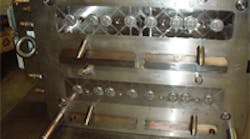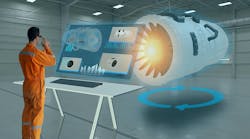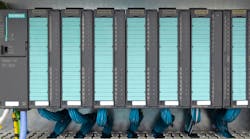Vaupell Midwest Molding & Tooling (www.vaupell.com), makes molded products and assemblies for the medical, defense, aerospace, electronics and transportation industries.
The company was using 2D CAD, but its customers wanted to see 3D models.
In addition, special demands of medical molding -- extremely small parts, exotic materials, and specific processing requirements – along with the need to effectively manage the high frequency of engineering changes forced it to look for a 3D design solution.
Vaupell chose Cimatron to provide the advanced mold design capabilities to enable it to make the transition to 3D design and to support the special requirements of medical applications.
By delivering products faster and providing 3D models of its molds, Vaupell improved productivity and elevated customer satisfaction.
“When we design with Cimatron, the models are already done. We just pull them in and start programming against them. It has taken two or three days of modeling out of the equation.” Eric Wagner, manager of Vaupell’s design department, said.
Vaupell was founded in 1947 and is a fullservice contract manufacturer with six operating facilities in the U.S. and China. The company is the third largest molder of high-heat advanced polymers used for critical medical and aerospace applications. It is one of the largest plastic molders in the United States, and a leader in resorbable resin molding. Resorbable material decomposes over time and aids in bone, muscle and tissue healing.
Vaupell designs, builds and uses molds that range from prototype and market entry molds to multicavity production tools.
Recognizing that quality tooling and rapid delivery are keys to its leadership position, Vaupell has invested in a state-of-the art tooling design and manufacturing facility in its home town of Constantine, Mich. Nearly 90 percent of the molds manufactured in the facility are for medical parts.
The tooling facility gets involved in the project from the early stages of interaction with the customer.
“They’ll send us a part model and usually some form of specs on how they want it done. We take the model, put together the quote for it, then design and build the tooling for it,” Wagner said.
Working with resorbable materials creates a special challenge for the Midwest Molding designers because it is highly sensitive to variations in temperature and process. In addition, many of the medical parts are extremely small in dimensions and require exceptionally tight tolerances. Special attention must be given to the runner and gauge sizes to work accurately with the mold.
“We have done a part where we’re dealing with a plus or minus of about one thousandth on a part with a 0.148-in. diameter,” Wagner said.
Another challenge that Vaupell had to address was the demand for 3D models and faster delivery times. After years of working in 2D using AutoCAD, customer demand and increasing delivery requirements motivated Vaupell to make the move to 3D.
“A major reason we moved to 3D was customer push. They wanted to see things in 3D. In addition, delivery dates were getting so tight that we couldn’t keep up, and we had to get new machinery and software to accommodate these demands,” Wagner said.
After evaluating multiple solutions, Vaupell’s Midwest Tooling shop chose Cimatron’s MoldDesign application to improve productivity, enhance the mold making processes, and support the transition to 3D.
According to Wagner, the rich set of dedicated applicative tools of Cimatron MoldDesign is helping Vaupell to meet the needs of medical molding more effectively.
He said part data is imported flawlessly, with corrections for gaps and geometry issues. There are dedicated tools for effective handling of sub-systems, including mold-base manipulation, ejection, cooling, and runner design. The ability to edit, reuse and catalog tools for streamlined mold creation saves time and helps maintain accuracy.
“We have been very happy with the accuracy of Cimatron. We have done a couple of designs that are fully ISO 12485 compliant (medical device quality management requirements for regulatory purposes), and it has been very easy to get the tolerances right,” Wagner said, indicating that moving to 3D could be a challenge.
“The ability to work in both 2D and 3D has allowed us to make the transition to Cimatron much easier for all involved. We needed to adjust to a new thought process, but the software itself wasn’t hard,” he said.
“Cimatron was very helpful in the process. All of our designers went through training, which was excellent. The support we got was great,” he added.
“Before, we would design everything in 2D, then follow with the actual model. Now, we program or design with Cimatron, and the models are done, and we can immediately start programming,” Wagner said.
Vaupell gained additional time in handling engineering change orders (ECO), he added.
“We are just building our history in Cimatron, but we’ve done a few engineering change orders in Cimatron, and the results are amazing. You bring the new part in, you change it. What used to take us a day, might only take us half a day to do now. Automatically updating engineering change orders is huge for us because, as a captive shop, we have a lot of engineering changes,” Wagner said.
Most importantly, Wagner added, his customers are happy: “They are able to see a solid model of the mold. They can open the model and see everything and exactly how we’re doing it.”
“We fought going to 3D; we didn’t want to go through the change, didn’t see a need for it. Now we sit down and try to figure out why we didn’t,” he said.








